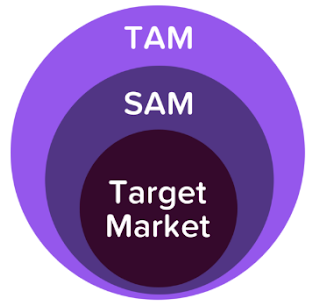Assessing Market Opportunities for Your Startup
 |
| Accessing Market Opportunities |
Many entrepreneurs
have billion-dollar ideas on their hands, but they are not sure how to turn
their dreams into successful startup.
As we learned
in the previous chapter of my post, customer discovery is the first stage of
the customer development process.
Your first
goal as a potential startup founder during the stage of ideation is to translate
your vision of the company into business model hypotheses. But where to start?
Determine Size of Market Opportunity
You first
need to determine the size of your market opportunity—that is, what type
of market you will pursue, and whether it is large enough to be profitable.
Nothing is worse
than spending several years trying to bring a product to market, only to find
out that not many people want it!
Although big
companies can afford to pay someone to do the legwork for them, startups are
often on a tighter budget.
You will
need to conduct primary research—new research that you conduct
yourself—and obtain secondary research, which you get from other sources
which include but not limited to, government sources, industry trade associations,
Google and public libraries.
Determine Your TAM
To estimate
the size of your market opportunity, the first value you will need to calculate
is the total addressable market (TAM), or the maximum market demand for
a product or service. This number assumes that everyone who can use your
product buys it, ad there is no competition.
Let’s say
you are into car wash service. Your TAM would be the amount all car owners annually
spend on washing their cars.
Narrow Down To SAM
Next, you
will narrow the TAM down to arrive at an estimate of your served addressable
market (SAM): the portion of the TAM targeted by your product that is
feasible within reach of your company’s sales channels.
If your TAM
is ₦30 billion, and you estimate that
only 10% of that market is reachable (Lagos, Nigeria) for a service like car
wash, then your SAM is ₦3 billion.
 |
| Startup market |
Estimate Your Target Market
Finally, you
will estimate the size of your target market, or a particular group of
consumers at which a product or service is aimed.
As an online
car wash service, your target market will be busy office workers with access to
internet.
Top-Down Vs Bottom-Up Analysis
To calculate
your estimates, your will either use a top-down or bottom-up analysis.
In a top-down
analysis, you will start with an estimate of the total market and narrow it
down to your predicted share of that market.
In a bottom-up
analysis, you will start with an estimation of one component of your business,
and see how large it could scale up.
A top-down
estimate is usually simpler to calculate than a bottom-up one, but may be too
optimistic when the data is not narrowed down enough.
Examples of
top-down and bottom-up analysis of the market for an ice cream delivery service
in Lagos, Nigeria.
|
Top-down Analysis |
Bottom-up Analysis |
||
|
Total expenditure per year on ice cream in Nigeria |
₦20B |
Price per ice cream cone |
₦500 |
|
2.6% Nigeria population live in Lagos |
₦515M |
average Nigerian eats 15 cones per year |
₦7,500 |
|
30% desire delivery |
₦154.5M |
4.3 average members per household in Lagos |
₦32,300 |
|
+9% market growth
expected |
₦168.4M |
500,000 estimated Lagos households regularly use delivery |
₦161.5M |
For top-down,
up are starting with the size of the entire ice cream market for Nigeria and
then narrowing it down. While for bottom-up analysis, you are beginning with
the price per ice cream cone and then estimating sales with available
demographic data.
Examples of
questions you should ask in a bottom-up analysis can be put in the following
order:
1. How much will the average Lagosian
pay for one cone of ice cream? We could assume 20% of Lagosians will buy a cone
of ice for ₦500—so your target market will average ₦100 each.
2. How many households does the average Lagos
ice cream outlet serve? Here, you multiply ₦100 per customer times the number
of households—let’s say 1,000 customers for a total market of ₦100,000 at one
store.
3. How many ice cream outlets are in
Lagos? Now we multiply the market at one outlet by the number of outlets in the
area. If we say there’s 30 outlets, then you have a total target market of ₦100,000
x 30 = ₦3,000,000!
T Type of Market and Entry Method
It’s not just size that matters—you will also need to assess
how the type of market impacts your product’s viability and overall strategy. Generally,
you bring a product to market by:
· Entering an existing market;
· Creating a new market;
· Re-segmenting an existing market—targeting
only a small portion of the market, such as by providing a low-cost or niche
product;
· Or recreating a successful model in another
region.
Example of
an existing market is the online streaming service Hulu founded
as a joint venture by Disney, Fox, and NBC (among others) in order to compete
head-on with Netflix.
Zalando is a German online retailer that
initially only offered shoes online, inspired by its American counterpart
Zappos. Hence, Zalando is an international clone of Zappos.
An example
of new market is SpaceX which was launched with the intention of
making space travel accessible to the masses.
Ryanair became one of the largest European
airlines by offering no-frills flights for lower prices—re-segmented market
(low-cost).
While an
example of re-segmented market (niche) is Shake Shack, founded by
restaurateur Danny Meyer. Shake Shack offers elevated fast food at over 160 locations
worldwide.
In an existing,
mature market where there are many players vying for market share, it can be
easier to penetrate and outperform competitors. But if an existing market is
dominated by one or two players, it’s usually best to avoid head-on competition
(In fact, according
to the New Lanchester Theory,if you want to attack the market leader in a monopoly,
you will need to have three times more resources than your competitor.) and re-segment or even create a
new market to snatch market share away.
Of course,
there are always exceptions. Some fragmented markets cannot be penetrated
easily: automotive manufacturing is very resource and capital intensive, so
barriers to entry in that industry are high.
Conversely, markets
with one or two dominant players that are still evolving are sensitive to the
introduction of innovations and new technology (When Casper was launched
in 2014, its novel business model garnered $1 million in sales within 28 days.
Now, it’s trying to use product innovation to stand out from the herd of
copycats that have since entered the market).
Introducing Your Product into the Market
To enter certain markets dominated by one or two players, you will need to re-segment or go rogue, or create a new market and not compete head-on. Example include: Internet
search engine market, dominated by Google; the large passenger airplane
manufacturing market, in which Boeing and Airbus vie over the lion’s share of
customers.
Some of the
market to compete head-on with include: The European health club industry, in
which top 30 players combined only have 23.5% market share; the book publishing
market which is overrun by publishers both large and small.
Granted, accurate
market estimations may not always be possible (read more here),
especially when creating new markets.
Although you
will ultimately decide how you introduce your product at a later stage, it’s still
important to have a working market hypothesis you can use to frame the rest of
your model.
Importance of Market Research
Want an
illustration of how important market research is? Check out this case!
Before
founding Amazon, Jeff Bezos carefully researched the top 20 mail-order
businesses in the US.
What do you
think he did with the information he collected?
He
identified which industry was struggling and could be fixed. He discovered that
the mail-order book industry was failing due to high cataloging costs, and identified
that technology could easily solve this problem.
And what
happens if you don’t do your research?
Well, the
bookstore Borders invested heavily in the CDs and DVDs, just as the industry
was going digital. Failing to research the growing role of digital media led to
the decline of the business in 2011 (read more here).
Their
competitor Barnes & Noble, on the other hand, dis their research and
invested heavily in their online sales and e-reader, enabling them to survive.
CONCLUSION
Let’s
review! Your co-worker, Aisha is researching her idea for a software company
that provides secure online health records for veterinary patients.
Can you
answer the following questions about her process for assessing the marketing
opportunity?
1. Aisha interviews office managers at
local vet clinics to learn more about their current health record management
systems. What kind of research is she conducting?
2. Aisha wants to know how big her
business could theoretically get, if she sold her software to every
veterinarian on the planet. What is she looking for?
3. Aisha estimates the size of her
market by starting with the revenue she’d make at one clinic, then working her
way up. What kind of analysis is this?
4. Aisha finds that there are dozens of
software service for managing pet health records, but none has a dominant share
of the market. How should she proceed?
The answers
to the above questions are: Primary research, TAM, bottom-up analysis and “Go ahead
and enter the market!” respectively.
You entering
a brave new market with your devise—although you won’t have to outspend
competitors, you will have to invest heavily in customer education and marketing
to get the word out about your online ice cream delivery service.